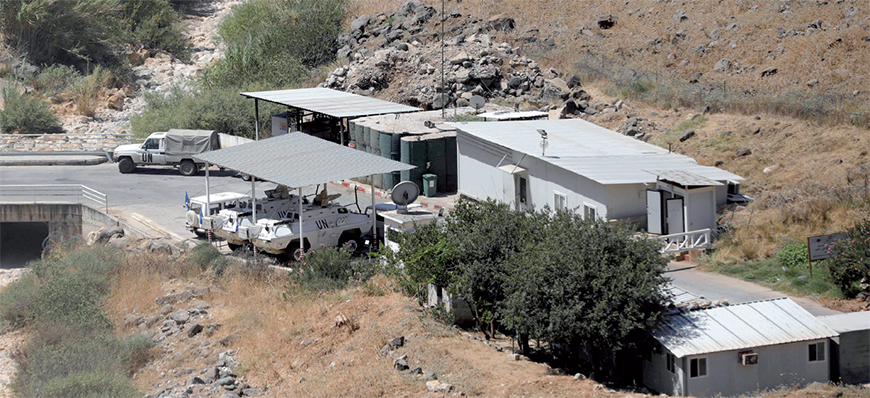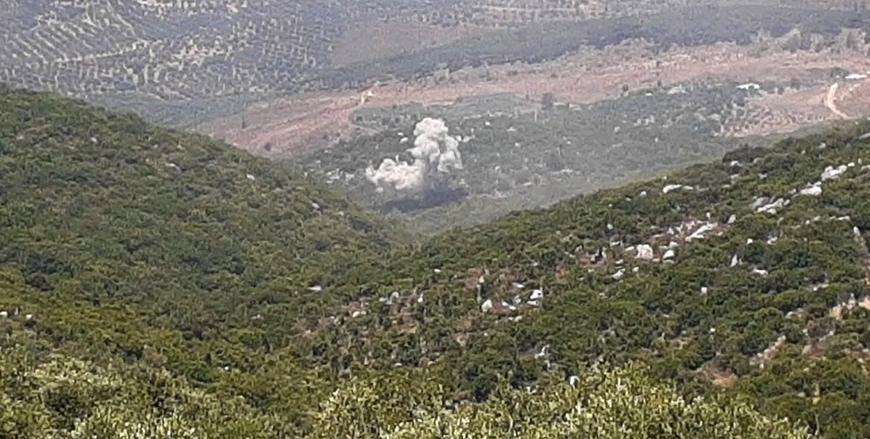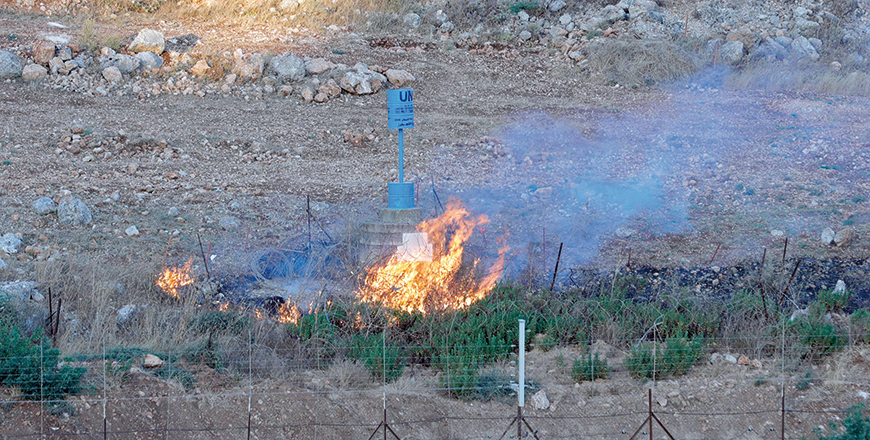You are here
Divided border village at heart of Israel-Lebanon tensions
By AFP - Aug 24,2023 - Last updated at Aug 24,2023

This photo taken from the village of Ghajar shows a base of the United Nations Interim Forces in Lebanon along the border fence separating Lebanon and Israel, on August 9 (AFP photo)
GHAJAR — Straddling the frontier between Lebanon and the Israeli-occupied Golan Heights, the picturesque village of Ghajar has become a lightning rod for tensions between the hostile forces on either side.
The latest tit-for-tat exchange saw Israeli Defence Minister Yoav Gallant and the chief of Lebanon’s powerful Hizbollah movement, Hassan Nasrallah, vow to send the other’s country “back to the Stone Age” if the other escalates violence.
On the sleepy streets of Ghajar, home to manicured flower beds and ice cream trucks, an invisible boundary is intended to keep the two sides apart.
“The Blue Line is in the air,” resident Abu Youssef Hussein Tawfiq Khatib told AFP, referring to the United Nations demarcation line drawn when Israeli troops withdrew from south Lebanon in 2000.
“You see that the town is open, there are no borders or anything,” added the 79-year-old, wearing a traditional white headdress near the village mosque.
But weeks earlier, Israelis erected a controversial fence topped with barbed wire on the Lebanese side of the Blue Line.
The move followed cross-border fire in April that was the heaviest since a devastating war between Israel and Hezbollah in 2006. That and other incidents have sparked fears of renewed conflict.
Any miscalculation could have devastating consequences. The month-long 2006 war killed 1,200 people in Lebanon — mostly civilians — and 160 Israelis, mostly soldiers.
With the neighbouring countries still technically at war, Lebanon condemned the Ghajar fence as a unilateral Israeli “annexation” of the northern part of the village.
On July 6, an anti-tank missile was launched from Lebanese territory towards the new barrier, prompting retaliatory strikes by Israeli forces.
‘Atmosphere of alert’
Despite the cross-border exchanges, Ghajar resident Nahlah Saeed insisted that right now “here’s safe — Israel’s safe”.
“In the future, I don’t know. I know that I live well, happily,” said Saeed, 63, sitting in the shade outside a house.
According to municipal figures, the village is home to around 3,000 people, who took Israeli citizenship after Israel seized the Golan Heights from Syria in the 1967 War and then occupied it in 1981 in a move never recognised by the international community.
Village spokesman Bilal Khatib said residents had the “right to build a fence around our own homes”.
“The council built the barrier and stopped the soil being swept away, protecting these homes. A second reason was that we had, more than once, wild animals entering the village,” he told AFP in his office.
Under the scorching sun, UN peacekeepers patrol the northern side of the new fence, which is metres high and looks over Lebanese homes in the village of Wazzani.
On both sides of the Blue Line, local officials told AFP about title deeds and pointed to maps which they said prove their ownership of the disputed land.
Wazzani mayor Ahmad Al Mohammed said he has “adapted to the atmosphere of alert”.
“In recent years, there was Israeli bombardment, which took a human, material and livestock toll. But people don’t leave the village, because they must be tied to their source of livelihood,” he told an AFP journalist in south Lebanon.
Lebanese authorities consider the expansion of Ghajar, with its pastel-coloured homes spreading to the north in recent decades, as an infringement on their land.
On the outskirts of Wazzani, shepherd Imad Al Mohammed rode a horse as he took his flock out to pasture.
“When the Lebanese lands in the vicinity of Ghajar are recovered, the pasture lands will increase and I’ll take the sheep there,” he told the AFP correspondent, pointing across to homes now behind the Israeli fence.
‘Peace before everything’
The UN is mediating the fence affair and acts as an intermediary in talks over the Blue Line, at which refreshments must be served separately to the opposing sides by the Italian contingent.
“Despite all the tensions in the area, there is still a commitment from the parties, or no appetite for a conflict,” said Andrea Tenenti, spokesman for the United Nations Interim Force in Lebanon (UNIFIL).
Under international agreements backed by the two governments, “Israel is obliged to withdraw from the northern part of the village of Ghajar”, Tenenti said.
Lebanon, meanwhile, is obliged to remove a tent that was erected across the Blue Line northeast of Ghajar earlier this year.
An Israeli security official, speaking on condition of anonymity as he was not authorised to speak publicly, said the “rogue terrorist army” Hizbollah was behind the tent and UN mediation on the matter was underway.
“Nobody wants this to escalate, right, so he [Nasrallah] is also trying to keep it under the threshold. We’re keeping it under the threshold,” the official said.
He cited Israeli forces using non-lethal weapons to push back Hizbollah members who approached the border around 40 kilometres southwest of Ghajar, wounding three fighters.
Standing within view of the valley, Khatib, the elderly Ghajar resident, underlined the importance of “peace before everything”.
“That’s it, and everyone has the rights that belong to them. I take the land that belongs to me, and he takes the land that belongs to him,” he said.
Related Articles
GHAJAR — The Israeli forces said on Thursday they struck southern Lebanon after a mortar launched from its northern neighbour exploded in th
BEIRUT — Israeli forces fire wounded three members of Lebanon's Iran-backed Hizbollah movement on Wednesday near the border with Israel, a s
NAQOURA, Lebanon — Lebanon and Israel have been holding talks nearly every day over a border dispute that has raised tensions between the tw













